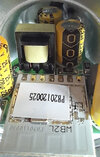The
incandescent light bulb can be long lasting however the light output at 1/10th of design is not really going to light much, and when I used tungsten rather than carbon filament bulbs I would change one around every 2 weeks, not the same one, but around 16 bulbs in regular use, so around 6 mouths per bulb.
When using fuses the ionisation (bright flash when bulb blows) did not take out the re-wire-able fuse, there was suppose to be a fuse built into the bulb which should rupture first, but this was when bulbs made in the UK, I found some imported bulbs did not have this fuse when one from Ikea welded its self to the contacts on failing, not helped since using a 16 amp MCB on that bulb, the 6 amp MCB would trip before any bulbs welded them selves to holder, but the solder contacts would often misshape forming a dint in centre which would make removal a problem in some cases.
Although the supply was originally rated at 240 volt, it was always on the high side, more like 250 volt, even when officially it dropped to 230 volt with harmonisation the real voltage did not change until solar panels were fitted so some homes in the area when the voltage did drop, seems solar panels must auto disconnect if voltage not in the 207 - 253 volt range, so likely complaints that they kept auto disconnecting.
The compact fluorescent bulb (CFL) was claimed to last longer, however when I fitted 16 after just one years I was replacing bulbs, and even with LED had a fluorescent tube replacement last less than 18 months, one odd bulb went within a day, although latter fixed, opened to see what was inside the bulb and found a dry joint and a smart bulb failed within a few month, they are rather complex,

so like any bit of electronic equipment you will get the odd one fail, but in the main LED lamps last for years, although my son seems to have had a bad batch, although he does not have a surge protection device (SPD) fitted, so not sure if failed due to surge or poor bulbs.
I have had bulbs go dim, not quite as bad as the centennial light, but both CFL and LED seem to have reduced output, I will continue using tungsten bulbs in the oven, and a table light with built in dimmer, but in the main when a tungsten fails it is replaced with LED.
Before the quartz bulb I did fit dimming switches which seemed to extend bulb life, however ionisation could take out a dimming switch, so swings and roundabouts really, and with quartz you should not dim the bulb as it shortens the life, so when the CFL arrived any dimmers were removed, and when the LED arrived easier and simpler to use smart bulbs, removed the problem matching electronic switch with lamp.
I have last more electronic switches than lamps, of 5 smart switches now down to 2, used with remote controls for bedroom lights so we and switch on/off in bed, but more bulbs changed because they flash or flicker with smart switches then changed because they have failed.
The problem today is more having a draw full of new bulbs due to old stock of tungsten, or swapping LED as too bright or dim for location, or flickered with electronic switch, not helped when tungsten bulbs came as packs of 10. Still loads of CFL sent to parents by electric supply companies to encourage them to use energy saving, all BA22d and there are so few fittings still using that base they will last for years. Seems I now have mainly E14 or SES base bulbs.
Good job bulbs last longer, as very few rooms with less than 4 bulbs, living room ceiling light has 8 bulbs, this is in the main due to LED lamps being in the main directional, a single 100 watt tungsten bulb had just a small area where the base was where there was no light, replace with LED, as first problem is 100 watt tungsten is around 1000 lumen, it may be claimed a 15 watt LED gives same light, but in real terms needs around 20 watt plus, and the second is all the light being directed to a dark floor does not really give same spread as when reflected off a white ceiling.
So moving tungsten to LED has resulted in changing light fittings so we can get the extra light, with 3 to 8 bulbs per fitting, this also means one wants the bulbs in the main to match, OK I do have one where centre bulb is different to outers by design.
Bulb blowing is likely more of a problem today as we have G9, G10, E14, E27, BA22d, and other bulbs, where years ago all were BA22d, and they last so long we will once existing stock is gone, likely not keep replacements in stock, but only buy as and when the blow.
Main problem is disposal, we should not put LED bulbs into general waste, however to travel 16 miles to dispose of the bulb is silly, I have seen boxes for batteries in shops, but not bulbs, I know they should take them for recycling, but last time I took a fluorescent tube to
Wickes for disposal when getting a new tube they refused, so it sat outside house until wind knocked it over and is smashed, at which point it was swept up and put in general waste, may as well have put it there to start with then mercury would not have gone into my garden. I note bulbs from Lidi have the

symbol not

but seems it only means do not litter, not it can be put in the bin.






